Suffolk Gazetteer
There’s something rather special about cycling holidays and walking breaks in Suffolk.
You’ll find it by the creeks and coastline, in the medieval timbers of pink-washed cottages, or perhaps simply all around you in the warm Suffolk light, refreshing air and enormous wrap-around skies.
We can’t pinpoint which bit of Suffolk you’ll find the most appealing, but we’ve tried to give a little background to a few of our favourite places included in our Suffolk walking breaks and bike tours of England.
Solo Walking Holidays
Travelling alone? Our breaks are perfect for solo exploring!
Find out more about cycling in Suffolk

 Aldeburgh
Aldeburgh
See the fishermen hauling up their boats onto the shingle beach at this fine old-fashioned seaside town. A great place to eat fresh fish and chips, watch the model yachts on the boating pond or stroll along the High Street with its interesting shops. Home to the now (in)famous Maggi Hambling scallop sculpture inspired by the work of composer Benjamin Britten. The town has given its name to the famous music festival – if you wish to attend a concert we will be happy to send you details in advance.
 Bawdsey
Bawdsey
Sitting within the Suffolk Coasts and Heaths an ‘Area of Outstanding Natural Beauty’ – Bawdsey is home to a foot ferry service across the mouth of the River Deben to the village of Old Felixstowe. The village is renowned for its late 19th C. Manor House which is where radar research took place early in World War II. Tons of granite from Norway help protect the coast from erosion here.
 Bildeston
Bildeston
In the 15th C. this thriving village was an important centre for ‘blue’ broadcloth. Today the streets still have many timber-framed houses and little pink weavers cottages from the period. The square at the centre of Bildeston is particularly picturesque overlooked by Georgian facades and the Grade II listed Victorian clock tower.
 Boxford
Boxford
Set amongst a wooded valley, this pretty village has attractive buildings, some timber-framed, some Georgian, whilst others display raised decorative plasterwork (known as pargeting). Like so many other villages in the area, Boxford became prosperous through the former cloth-making industries. St. Mary’s Church is noted for its tall spire and timbered 14th C. porch.
 Bressingham
Bressingham
Twenty acres of beautiful trees, shrubs and flowers, alongside over fifty steam engines – some of which run on the four narrow gauge lines through woodland, gardens and beside the River Waveney. The gardens are the legacy of Alan Bloom, and include the famed Dell Garden, rich with herbaceous borders; alongside Foggy Bottom, the shrub paradise created by Alan’s son, Adrian. Take a nostaglic ride on the Victorian Gallopers, or visit the museum with its vintage vehicles and Dad’s Army memorabilia.
Bungay
Set on a loop in the River Waveney, this is a fine and unspoilt market town with lots of interesting little shops and a certain understated elegance about it. The ruthless Bigod family rebuilt the Norman castle here, but it was in ruins by the 14th C. Following a great fire in 1688, the town rebuilt itself with Dutch gables and Georgian town houses. The domed Buttercross was constructed in 1689. A weathervane depicts the famed devil dog of East Anglia – Black Shuck who visited the town in 1577.
 Bury St Edmunds
Bury St Edmunds
An ancient market town, full of history and old Suffolk charm. Walk through the massive stone gateway to the ruined abbey, now forming the backdrop to beautiful and award-winning gardens. The magnificent cathedral is noted for its stunning Millennium Tower. Visit on Wednesday or Saturday for the excellent open air market. Other treats include taking in a show at the historic Theatre Royal, a guided tour of the Greene King brewery and a pint at The Nutshell – Britain’s smallest pub.
 Cambridge (Cambridgeshire)
Cambridge (Cambridgeshire)
This famed University town set on the River Cam is home to 31 colleges, and boasts an incredible list of past scholars from Sir Isaac Newton to Stephen Hawking. Take a guided tour to really get to grips with this historic city and its collection of architectural wonders – from Peterhouse, the oldest college (founded 1284) to the impressive Trinity College with its Great Court and fine Wren Library. The Fitzwilliam Museum is a must, as is a visit to King’s College Chapel to experience evensong or just to wonder at the amazing fan-vaulted ceiling. No visit to Cambridge is complete without a trip on the river by punt, either have-a-go yourself or take the chauffeured option and enjoy some wonderful views of the colleges from ‘The Backs’.
 Cavendish
Cavendish
A real picture postcard, with its large open green overlooked by a row of ‘Suffolk Pink’ thatched almhouses and the 14th C. church. Cavendish grew prosperous as a result of the medieval wool trade and this wealth is seen today in the many fine buildings. The village sign depicts the Peasant’s Revolt of 1381 and the death of leader Wat Tyler at the hands of the son of Sir John Cavendish, Lord of the Manor.
Castle Hedingham
Dominated by its 12th C. castle keep, this large village has a medieval street plan, with narrow lanes lined with timber-framed and Georgian buildings. The Norman church is noted for its carved stalls, rare wheel window and double hammerbeam roof. Built by Aubrey de Vere (and still owned by one of his descendants), the castle is well worth a visit to explore the magnificent Banqueting Hall and beautiful woodland gardens.
Chelsworth
A beautiful little village of half-timbered cottages, Georgian facades and rambling rectories. For over 40 years, the village has staged a renowned Open Gardens Weekend which really shows its English country charm at its best. All Saints’ Church has an idyllic setting by the River Brett, and the 14th C. Peacock Inn sits opposite the village’s delightful bridge.
Clare
A delightful small town with colour-washed and timber-framed buildings with lots of fine examples of pargetting. The town has connections through it’s 13th C. church with Clare College in Cambridge. Whilst the 13th C. priory was the first Augustinian house in England. Today the old railway station area is included in a lovely country park which is dominated by a 100ft high motte, once home to a Norman castle. Clare is well known for its antique shops and real Suffolk charm.
Covehithe
The road through this small settlement ends dramatically at the crumbling cliffs which sweep down the coast to the seaside town of Southwold. A short distance inland are the melancholic ruins of the enormous medieval church, which was deemed to large in the 17th C. and was replaced with the smaller thatched building built within the shell – a ‘church within a church’. 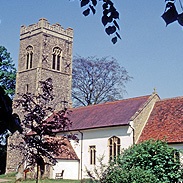
Darsham
The village of Darsham is situated just off the main A12 road between Ipswich and Lowestoft. It is home to a little railway station which offers excellent access (by taxi) to the nearby coastal village of Dunwich and the famous RSPB Minsmere Nature Reserve. The flint All Saints’ Church has elements dating back to the 12th C.
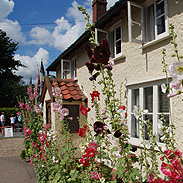 Debenham
Debenham
A former court of East Anglian Kings, this attractive large village is set near the source of the River Deben. Once a thriving wool centre, Debenham has overhanging timber-framed houses and antique shops. It is also home to a world famous teapot pottery where visitors can watch them being made and painted by hand, then sample delicious homemade cakes in the tearoom.
 Dedham
Dedham
Set by the River Stour, this picturesque village is set in the heart of Constable Country. It was here that Britain’s greatest landscape artist went to school, walking across the meadow path between Dedham and his father’s former mill at Flatford. The main street is home to Georgian-fronted houses, old inns and a large art/craft centre. The magnificent 15th C. church was built from the wealth of the medieval wool industry and houses a Constable altar piece. Rowing boats can be hired on the river.
 Dunwich
Dunwich
A haunting place where the village all but lies lost beneath the waves. In the days of King John, this was the capital of East Anglia – a gated, ramparted town with at least eight churches. Visit the award-winning Dunwich Museum to learn how the village has disappeared over the years. Ruins still cling to the clifftop. No wonder, author P.D. James found this a fascinating place to gather up inspiration. Nearby is the wild landscapes of Dunwich Heath, with its colourful heather and gorse.
 East Bergholt
East Bergholt
The birthplace of John Constable – Britain’s greatest landscape artist. A plaque on some railings marks the location. Whilst a nearby cottage was used as a former studio. Visit the church – resting place of Constable’s parents, alongside a 16th C. bell cage on the ground next to the unfinished tower. The Devil is said to have cast down the tower at night as quickly as the builders could build it by day! This bell cage is one of the area’s finest and perhaps quirkiest medieval edifices.
Easton
Set beside the River Deben, this pretty village is famous for its meandering crinkle-crankle wall which surrounds the site of the former home of the Duke of Hamilton. The Queen Anne manor has long disappeared and more modern houses now fill the enclosure, but the Duke’s red-brick model farm built in 1870 still survives and has a new rural lease of life as the popular Easton Farm Park, home to rare breed animals and a Victorian dairy.
Felixstowe
Felixstowe is an Edwardian resort, retaining much of its original charm, with beautiful south-facing gardens, paved promenade and Spa Pavilion. It’s popularity began with the railway in 1887. These days, it also has its fair share of modern day seaside razzmatazz along the prom and pier. Felixstowe is home to the UK’s largest container port, situated to the south of the town beside the Landguard Peninsula (see below), with its historic fort, museum, nature reserve and view point.
 Felixstowe Ferry
Felixstowe Ferry
This little hamlet to the north of the town of Felixstowe is home to a foot ferry service across the mouth of the River Deben to the village of Bawdsey. There is a church and a handful of fishermen’s cottages, alongside a couple of pubs, the Ferry Cafe, a boatyard and local sailing club. A walk alongside the water will take you past two historic Martello towers.
 Flatford
Flatford
Just down the hill from East Bergholt, Flatford Mill was once owned by the artist John Constable’s father. A guided tour is a great way to be introduced to some of the local scenes depicted in Constable’s paintings such as “The Haywain”. Alternatively, why not rest up your feet and let your arms take to the oars – with rowing boats available for hire. What better than to experience the gentleness of the sedate River Stour – earning yourself a delicious afternoon treat in the riverside tearoom.
 Framlingham
Framlingham
A quiet and very authentic market town with many interesting buildings. St. Michael’s Church contains impressive historic tombs and effigies. The superb 12th C. castle was built by the Earls of Norfolk. The very well preserved curtain wall has thirteen integral towers – the design was considered revolutionary in its day. This was the home to Mary Tudor in 1553 when she learnt of her accession, and the castle owes its twisted redbrick chimneys to the splendour of the Tudor period.
 Hadleigh
Hadleigh
This busy market town in the Brett Valley was once a Viking royal settlement. Through the wool trade, it rose to become one of the most prosperous towns in the country in the 14th and 15th C. The medieval heart of Hadleigh is still very much in evidence, with many fine old buildings to be seen on the High Street, some displaying examples of pargetting. The magnificent church with its towering spire overlooks the churchyard with its timber-framed Guildhall and red brick Deanery.
Halesworth
In a curve on the River Blyth, this is a thriving market town with little shops and a growing number of art cafes. It was once a major centre for malting and brewing. There are many fine buildings including the carved Gothic House, a Tudor Rectory and Elizabethan almshouses. The town is dominated by the impressive St. Mary’s Church which has an unusual 18th C. altar and a memorial to a local father and son who both became directors of Kew Gardens in London.
Helmingham Hall Gardens
Noted for its Grade I listed gardens and deer park, this beautiful red-brick moated hall has been the home of the Tollemache family for 500 years. The house is not open to the public but gardens are a real treat: wander amongst a myriad of colourful and sweet-smelling herbs, roses, vegetables and overflowing herbaceous borders, including a classic parterre and stunning walled kitchen garden.
Ickworth House
This eccentric 18th C. house with a 105 foot high rotunda was home to the Hervey family for just over five centuries. The flanking wings were originally designed as a gallery to show off the fabulous paintings and sculpture which the 4th Earl of Bristol had spent his life collecting. A tour takes you through rooms with fine furniture, china, pictures and silverware; whilst down in the basement you can discover life ‘below stairs’ 1930’s style. Surrounding the house are beautiful Italianate gardens.
 Iken
Iken
Despite being a remote location, the village of Iken historically had many trading routes. As well as being an important fishing centre, sailing barges used to transport corn from Iken Cliffs to London in the 19th C. These days, it’s lost and sleepy, but for many their favourite hidden place in Suffolk. The thatched St. Botolph’s sits close up to the river. There has been a church on this site for almost 1350 years and it is an ancient place of pilgrimage. Inside is the remains of a Saxon cross.
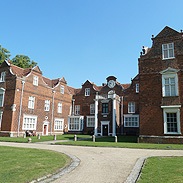 Ipswich
Ipswich
One of England’s oldest towns, dating back to Saxon times, though it is known more today for its busy shopping centre and University Campus. It’s streets are lined with historic buildings such as 12 medieval churches, alongside the Ancient House which has amazing pargetting. Sitting in parkland, the red brick Christchurch Mansion houses a fascinating free museum home to some of John Constable’s paintings. The town also has a rich maritime heritage, with a interesting waterfront and marina area.
 Kersey
Kersey
If you think Suffolk is flat – think again! This is most probably one of England’s prettiest villages. Half-timbered houses sweep down to the water splash where ducks seem to have right of way over everything which passes. The church stands high above the village like some proud grandfather. This is where Father Time has sat down to put his feet up. We suggest you do the same!
 Landguard Peninsula – Felixstowe
Landguard Peninsula – Felixstowe
Situated to the south of the town of Felixstowe, the peninsula is home to a wide range of attractions to enjoy. The fascinating Fort is one of England’s best-preserved coastal defences. Whilst at the Felixstowe Museum there are 14 rooms packed with treasures and artefacts to discover. Surrounding the Fort and Museum is a lovely Nature Reserve noted for its rare shingle habitat. Don’t miss the fantastic View Point overlooking the estuary and the UK’s largest container port.
 Lavenham
Lavenham
Not to be missed! This is simply the most spectacular of the Suffolk Wool Towns – wonderfully atmospheric, with a unique collection of medieval buildings. If you can tear yourself away from the maze of streets and lanes lined with half-timbered gems, or the amazing Guildhall of Corpus Christi on the Market Square, head uphill to the enormous medieval flint church with is massive tower. Lavenham offers a huge variety of shops, galleries, pubs and restaurants to enjoy.
 Long Melford
Long Melford
As the name suggests, this picturesque village (once one of the main Suffolk Wool Towns) is set alongside a broad attractive street over a mile in length – home to interesting shops and galleries. At the northern end is the magnificent church and two splendid Tudor red brick mansions – the privately owned Kentwell Hall famed for its re-creations of Tudor life; and Melford Hall, now in the safe-keeping of The National Trust. It offers links with the author Beatrix Potter.
 Manningtree
Manningtree
This town is set at the head of the Stour Estuary, its waterfront popular with sailing boats. There are many fine Georgian buildings at this historic old smugglers haven, which also boasts connections with the infamous Witchfinder General (Matthew Hopkins). The railway station set on the Essex and Suffolk border is noted for its renowned buffet and pub. From here there is a footpath out into Constable Country – across the beautiful water-meadows to Flatford Mill.
 RSPB Minsmere Nature Reserve
RSPB Minsmere Nature Reserve
This renowned RSPB nature reserve is set on the lovely Suffolk Coast, and features 2,000 acres of marsh, lagoon, reedbed, heath and woodland. The variety of birdlife here is immense, including wonderful Marsh Harriers, hallmark Avocets and the ‘booming’ Bittern. Even if you’re not a regular twitcher, you really have to take a look on one of the numerous trails.
 Moulton
Moulton
Attractive thatched and flint houses encircle a large green at Moulton, where visitors can cross over the River Kennett on the wonderful four-arched packhorse bridge dating from the early 15th C. It sits on the old route which ran from Bury St. Edmunds to Cambridge. St. Peter’s Church with its 14th C. tower is topped by an unusual weathervane in the shape of a large fish.
 Nayland
Nayland
On the northern bank of the River Stour, Nayland was one of the most important Suffolk Wool Towns in the late Middle Ages, with only Lavenham and Long Melford surpassing its wealth. There are a number of fine Tudor buildings, housing pubs and restaurants, alongside an impressive flint church – a reminder of the size and significance of this village in days gone by.
 Needham Market
Needham Market
A small town set in the Gipping Valley, it’s High Street lined with historic buildings, including fine Georgian facades, a 17th C. grammar school and the Friends’ Meeting House. A walk down towards the old watermill reveals little lanes of leaning houses and some half-timbered gems. The 15th C. church is a must, with one of the most impressive hammerbeam roofs in England. Enjoy a walk around Needham Lake, or explore the local craft shops and delicious delicacies at Alder Carr Farm.
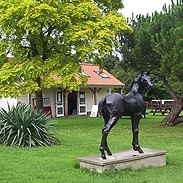 Newmarket
Newmarket
With more vets than doctors, traffic light systems for horses and even swimming pools for the equine beauties, Newmarket is an intriguing place where the horse is definitely king. If you’re visiting early, then head up to the Heath to watch the thoroughbreds on the ‘Gallops’, otherwise why not take an equine tour to discover the numerous stables and studs? Don’t miss the National Horseracing Museum or The National Stud. There are two racecourses, the Rowley Mile and the July Course.
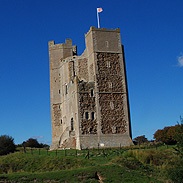 Orford
Orford
Now a small village, Orford was once a prosperous port in Elizabethan times. It is now inaccessible to all but pleasure craft due to the growth of the mysterious Orfordness, a shingle spit some ten miles long – and now owned by The National Trust. With its commercial lifeline cut off, the old world character of this charming coastal retreat has been preserved. The impressive 12th C. castle offers spectacular views over the surrounding area. Orford is also noted for its locally grown oysters.
Peasenhall
With a rich agricultural history, Peasenhall is linked to the 19th C. works of James Smyth who manufactured renowned seed drills. A family member also built a reading room (now the village hall) in the style of a Swiss chalet. A little watercourse runs the length of the main street lined with pretty buildings of timber and thatch. Emmets’ and Creasey’s are renowned for their traditional Suffolk hams and bacon.
 Polstead
Polstead
Set around its green, Polstead’s main street, lined with picturesque cottages and houses, drops steeply down to a large pond. Once noted for its cherries, the village will be forever linked with the infamous 1837 ‘Murder in the Red Barn’ of local girl Maria Marten by farmer William Corder. The gruesome reminders of this case can be examined in the Moyses Hall Museum at Bury St. Edmunds.
Shingle Street
This small and isolated coastal settlement is set at a quiet and beautiful spot beside the entrance to the Alde Estuary and the southern tip of the mysterious Orfordness. A bracing walk along the shingle beach will take you past an assortment of houses and cottages. The magnificent Martello tower is one of a set built along the east coast in the early 1800’s.
 Snape Maltings
Snape Maltings
Set at a lovely riverside setting, Snape Maltings is noted for its famous concert hall – home of the Aldeburgh Festival started by composer Benjamin Britten. There is a year-round programme of arts-based events. Take time to explore the interesting and quirky shops, galleries and food hall, then relax in the pub or tearoom. Tide permitting, you can also take a boat excursion around the upper reaches of the River Alde – a good way to see the animal and bird life of the neighbouring saltmarshes.
 Stoke-by-Nayland
Stoke-by-Nayland
Built on a hilltop overlooking the Stour Valley, this pretty village is home to jettied houses and oak-beamed pubs. The tower of 15th C. St. Mary’s Church (standing on the highest ground) is some 120 feet high. It can be seen for miles around, and was often featured in paintings by Britain’s greatest landscape artist John Constable who was born at nearby East Bergholt.
 Stowmarket
Stowmarket
Bustling market town set in the Gipping Valley. It’s medieval heart lay around the parish church with its impressive modern spire. The river was made into a canal in 1793, and this brought trade and prosperity to the town – with Stowmarket becoming a major producer of malt. You can step back in time at the excellent Museum of East Anglian Life, with its reconstructed blacksmith’s forge, chapel and watermill. There are also rare breed animals and nature trails down beside the river.
Sudbury
This ancient market town is built on a defensible loop of the River Stour. Surrounded by water meadows, Sudbury has thrived on the textile industry, firstly with wool, then silk – with items supplied to the Royal Family. The famous Suffolk artist Thomas Gainsborough was born here in 1727, and the house is now preserved as a museum and art gallery. Look out for his statue standing proudly on the Market Hill outside 15th C. St. Peter’s – one of several historic churches in the town.
 Southwold
Southwold
A distinguished seaside town with a definite old world charm. Elegant rows of pantiled Georgian cottages stand between broad greens on a cliff top above the North Sea. The white inland lighthouse overlooks the prom which is lined with colourful beach huts. The pier is a jolly place with some interesting artistic offerings and a tasteful restaurant too. Don’t forget, this is the home of Suffolk brewer Adnams, and a visit to the town is not complete without a tasting of their traditional ales.
 Sutton Hoo
Sutton Hoo
Located across the River Deben from Woodbridge, this is the site of the richest burial ever discovered in Britain – an Anglo-Saxon ship containing magnificent treasures. It is thought to be the grave of Raedwald, one of the earliest known English Kings, who died in c624AD. Piece together the story for yourself at the excellent exhibition, then take a walk out to the burial mounds. The property is in the safe-keeping of The National Trust and guided tours are available.
 Thorpeness
Thorpeness
A rather eccentric, but totally charming place just up the coast from Aldeburgh. Thorpeness is an Edwardian holiday village created from 1910 by Stuart Oglivie, and designed to provide self-catering holidays to families. Look out for an array of buildings with different architectural styles, alongside weather-boarded fishermen’s cottages. At its centre is The Meare – a freshwater boating lake, overlooked by a post-mill and the converted water-tower known as the ‘House in the Clouds’.
 The Sandlings Forests
The Sandlings Forests
In the early 20th C. three new conifer forests were created at Dunwich, Rendlesham and Tunstall. They were planted on former sandy heathland (known as ‘The Sandlings’) which once stretched from Ipswich to North Suffolk. They consist of a mix of blocks of conifers, broadleaved trees, glades and open grassy rides. A haven for wildlife such as the woodlark, nightjar, deer and many species of butterflies. There are miles of cycling, walking and riding routes to enjoy.
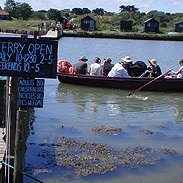 Walberswick
Walberswick
An attractive little seaside village at the mouth of the River Blyth. Very popular with artists in the early 20th C. there is a pretty green lined with flint houses, an historic church and a number of pubs, craft and gift shops. Tarred wooden huts overlook the river, with a pleasant walk along the creek to a footbridge leading across to Southwold Common. In the Summer months a small foot ferry also operates. Close by is the grazing marsh and reedbeds of the Walberswick National Nature Reserve.
Westleton
Noted for its 14th C. thatched church and annual barrel fair, Westleton’s colour-washed cottages are set around a sloping triangular green and pond. Just outside the village is one of the best remaining areas of ‘Sandlings’ heath, home to colourful heather, the haunting Nightjar and Silver-Studded butterfly. Close by is the famous RSPB nature reserve at Minsmere.
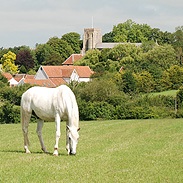 Wingfield
Wingfield
This village is home to a grand house with a Georgian facade hiding a magnificent medieval great hall – the remnants of a chantry college for priests. Sitting alongside is the impressive church where the tomb of the college founder – John de Wingfield (Chief Counsellor to the Black Prince) can be found. The barns of the college have links with the arts community and offer a programme of exhibitions and concerts. Enjoy a pint in the historic De la Pole Arms, a rambling pub with real character.
 Woodbridge
Woodbridge
Built on the banks of the River Deben, this attractive market town has a history of ship-building and sail-making. A stroll along the riverside will bring you to the famous Tide Mill which has recently undergone a major restoration project, with new displays and features. The narrow streets are home to historic pubs and an array of quirky and interesting shops. Relax amongst the floral displays of Elmhurst Park, or head up to the Market Square to find the Shire Hall and the impressive St. Mary’s Church.





